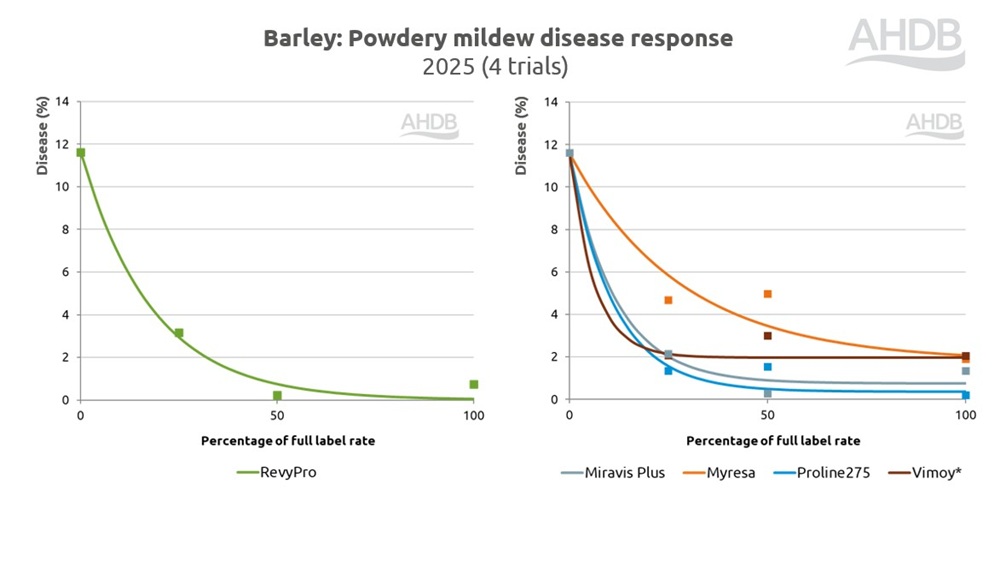- Home
- Knowledge library
- Fungicide performance dose-response curves for winter barley
Fungicide performance dose-response curves for winter barley
Our fungicide performance trials provide independent information on the relative efficacy of fungicides against rhynchosporium, ramularia, net blotch, powdery mildew and brown rust in winter barley. This page features the latest disease and yield dose-response curves.
Introduction
Data from our fungicide performance trials is used to plot dose-response curves. The charts show the average performance of fungicide products (disease and yield responses) across sites, seasons and leaf layers.
Curves that fit the data points well and have clear separation are most likely to reflect real differences (in terms of field performance).
To maximise differences between treatments, the trials use:
- High-disease-risk locations
- Highly susceptible varieties
- One spray timing
Products
It is not possible to test all products in fungicide performance trials. The products are carefully selected to:
- Provide the most relevant results
- Give equal opportunity for agrochemical companies to include products in trials
- Put emphasis on testing pre-registration or new active ingredients*
- Include standard products for which there is good understanding of performance (to aid comparisons)
*Only authorised plant protection products feature in the dose-response curves (unless stated).
Mixtures
- Ipresso – isoflucypram + prothioconazole: An SDHI and DMI/azole
- RevyPro – mefentrifluconazole + prothioconazole: Both DMI/azoles
Straights
- Proline 275 – prothioconazole: A DMI/azole
- Myresa – mefentrifluconazole: A DMI/azole
- Imtrex – fluxapyroxad: An SDHI
- Miravis Plus – pydiflumetofen: An SDHI
- Vimoy – isoflucypram (iblon): An SDHI
Further information
- Check product labels prior to use
- Most single active products are only recommended for use in mixtures with fungicide(s) with an alternative mode of action with efficacy against the target disease
Check the HSE plant protection product database for authorisation status
Dose-response curves
Note: For the cereal trials, the doses are quarter, half, full and double the recommended label rate (the latter improves the ‘fit’ of curves, but these results are not published online).
A selection of the key charts (released on 9 December 2025) are shown below.
Rhynchosporium
Disease response (protectant)
 2023–25.jpg) AHDB
AHDB
Disease response (eradicant)
 2023–25.jpg) AHDB
AHDB
Ramularia
Disease response
 AHDB
AHDB
*Vimoy does not currently have a label recommendation for the control of ramularia or powdery mildew, so it should not be applied to specifically control these diseases.
Net blotch
Disease response (protectant)
 2023–25.jpg) AHDB
AHDB
Disease response (eradicant)
 2024–25.jpg) AHDB
AHDB
Powdery mildew
Disease response
 AHDB
AHDB
*Vimoy does not currently have a label recommendation for the control of ramularia or powdery mildew, so it should not be applied to specifically control these diseases.
Brown rust
Disease response
 AHDB
AHDB
Summary
Rhynchosporium
- DMIs (Myresa, Proline and Revypro) and SDHIs (Vimoy and Miravis Plus) tested all gave very good control
Net blotch
- The SDHIs Vimoy and Miravis Plus were both very effective. Azoles, Myresa, Proline and Revypro (prothioconazole + mefentrifluconaozle), were also effective
Ramularia
- Miravis Plus gave the highest levels of control and Myresa was more effective than Proline
Powdery mildew*
- Prothioconazole still very effective on powdery mildew, as was the SDHI Miravis plus. Myresa also gave useful control
Brown rust*
- Miravis Plus and Proline appeared effective (1 trial)
Mixtures offer the broadest spectrum and most robust control.
*The fungicide performance project consortium works closely with Teagasc (Agriculture and Food Development Authority) in the Republic of Ireland to share dose-response data, which includes data from powdery mildew and brown rust trials in Ireland (Carlow).
All fungicide performance results
The full fungicide performance results cover all target diseases for wheat, barley and oilseed rape.
Most charts on this web page show the average performance of fungicide products over multiple seasons.
The full results also include single-year data.
The latest results are released in December at the annual AHDB Agronomy Conference. These are available, alongside the presentation slides and video, from the fungicide performance home page.
Further information
A guide to fungicide performance
Fungicide programmes for barley
Guidance from the Fungicide Resistance Action Group (FRAG)
Rhynchosporium management in winter barley
Ramularia management in winter barley
Net blotch management in winter barley
Brown rust management in cereals
Powdery mildew management in cereals
Back to: Fungicide performance in cereals and oilseed rape home page

